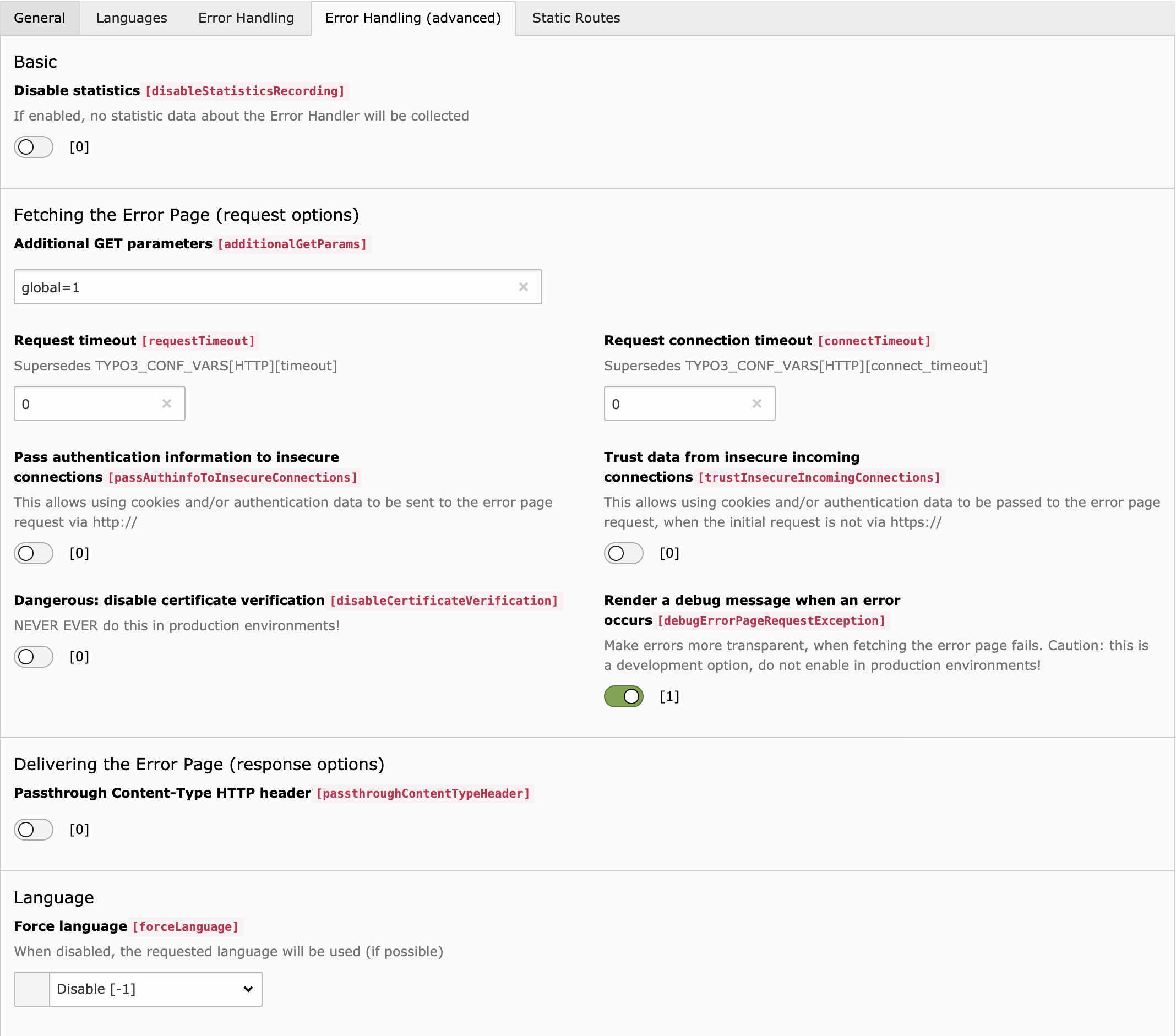Advanced Error Handling¶
The advanced Site-wide options that define the behaviour of the Error Handler.

Advanced error handling in Site Configuration
Category: Basic¶
disableStatisticsRecording¶
- Datatype
- bool
- Description
- If enabled, no statistic data about the Error Handler will be collected
- Default
false
Category: Fetching the Error Page¶
additionalGetParams¶
- Datatype
- string
- Description
- Same as
additionalGetParamsin Site Error Handling, but applies to all registered error handlers of the Site.
requestTimeout¶
- Datatype
- int
- Description
Supersedes
TYPO3_CONF_VARS['HTTP']['timeout'](see HTTP request library / Guzzle / PSR-7). Any value below1is ignored.If
TYPO3_CONF_VARS['HTTP']['timeout']is smaller than1, the timeout will be set to30.- Default
0
connectTimeout¶
- Datatype
- int
- Description
Supersedes
TYPO3_CONF_VARS['HTTP']['connect_timeout'](see HTTP request library / Guzzle / PSR-7). Any value below1is ignored.If
TYPO3_CONF_VARS['HTTP']['connect_timeout']is smaller than1, the connect_timeout will be set to10.- Default
0
passAuthinfoToInsecureConnections¶
- Datatype
- bool
- Description
This allows the usage of authentication data in the request that fetches the error page via unencrypted
http://.This can come in handy on development systems, that do not have
https://available, or in setups, where the webserver lives behind an SSL proxy.Danger
Never enable this on production systems unless you really know what you are doing, as the authentication information will be transferred over an unencryped (=plaintext) connection!
- Default
false
trustInsecureIncomingConnections¶
- Datatype
- bool
- Description
This allows the usage (and passing along) of authentication data, that is received through an unencrypred
http://connection.This can come in handy on development systems, that do not have
https://available, or in setups, where the webserver lives behind an SSL proxy.Danger
Never enable this on production systems unless you really know what you are doing, as the authentication information from an unencryped (=plaintext) connection cannot ultimatively be trusted!
- Default
false
disableCertificateVerification¶
- Datatype
- bool
- Description
Disable the verification of the TLS certificate when making the connection to fetch the error page.
This can come in handy on development systems, that use self-signed certificates.
Danger
Never ever enable this on non-development systems! This option is development only.
- Default
false
debugErrorPageRequestException¶
- Datatype
- bool
- Description
Show debug information, when the request that should fetch the error page fails.
Caution
This is a debugging option, do not enable in production environments, as it will show non-public information!
- Default
false
Category: Delivering the Error Page¶
passthroughContentTypeHeader¶
- Datatype
- bool
- Description
- Add the value of the HTTP header
Content-Typefrom the response of the error page fetching request to the response that is sent back to the user. Thus: “passing it through”. - Default
false
Category: Language¶
forceLanguage¶
- Datatype
- int
- Description
When composing the URI of the error page, always use the language with this
languageId.When the Site Language cannot be found, the default language will be used.
Note
The default setting will suit almost all needs. It is likely that you should not use this option at all.
- Default
-1
